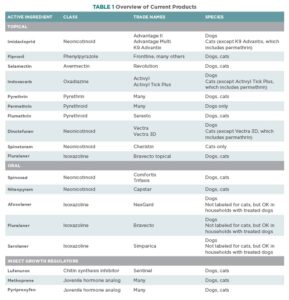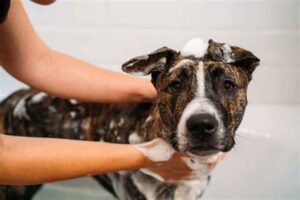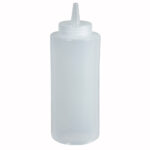What Are Some Simple Non-Toxic Flea & Tick Remedies?
Before we get into learning about Non-Toxic Flea & Tick Remedies, I want to share a personal note with you as a human and as a pet parent. We do the best we can with the knowledge we have on hand. We have trust in those that we are told are “experts”.  There is no reason to look further for additional information until we become aware that it may be important to do so.
There is no reason to look further for additional information until we become aware that it may be important to do so.
This is how I started and I know I am not alone.
This article is not just about non-toxic flea and tick remedies, but about how most conventional methods are described as safe, while at the same time, making sure they let us know they are not safe. It is very confusing for anyone so I hope this helps you.
I used various versions of topical flea pesticides, shampoos, treated collars, and more on my pets in the past. I had no idea at the time that I was literally poisoning them. I mean, what I was doing was recommended by our vet and we were told it was perfectly safe. I typically used a lower dosage than what was recommended and only used during “flea season” instead of all year, but still, I was putting toxic chemicals on and in my pets.
I remember one time about 38 years ago…my best kitty friend, Sherbie, had a scary reaction to one of the topical flea products. After putting it on her she started frothing at the mouth and running around like a crazy cat. This behavior only lasted a short time and the vet said not to worry. Of course I feel really bad, stupid, and angry about what I did, but I am also a big believer in “know better – do better” without shame or guilt.
So, I will no longer put any of those chemical toxins on my pets to ward off fleas or ticks. That is my choice as of now.
I can tell you that there was one time when the fleas ravaged our home in Virginia and we chemically bombed the crap out of it! We had been away on vacation and the fleas took over AND they were HUNGRY.
Imagine walking around on carpet for 15 seconds and having your white “tube”socks turn black with fleas! YES – we were completely infested and we freaked! We left and let the pesticides in – I still believe that this was a reasonable choice given the situation.
The CDC does have lots of information and some of it is helpful. Here’s the problem, they will always recommend the insecticides for your pets, your yard and for you, while quietly disclosing the true risks!
Here is a great example for a class of flea and tick products for dogs and cats that has been shown to have serious side effects – so much so that they updated their information in 2021, but is still “safe and effective”.
“The FDA considers products in the isoxazoline class to be safe and effective for dogs and cats but is providing this information so that pet owners and veterinarians can take it into consideration when choosing flea and tick products for their pets.”
My goal here is to give you enough information so you can make your own informed choice about how to handle flea season for your pet, you, and your home. I am not a vet, nor do I know anything about your unique situation, so please us my information accordingly. Like I said..it is about education and choice.
A Little More About Toxic Flea and Tick Remedies
Traditional topical or oral flea control products work to protect animals from getting fleas through different means, but their primary goal is to kill fleas or prevent their reproduction. Let’s look at how each type of product works:
- Topical flea control products are typically applied directly to the skin of your pet, usually on the back of the neck or between the shoulder blades. These products contain active ingredients that are absorbed into your pet’s bloodstream or spread across the skin’s surface to provide protection.
 a. Insecticides: Many topical products contain insecticides such as imidacloprid, fipronil, or pyrethroids. These chemicals are toxic to fleas, attacking their nervous system upon contact or ingestion. When a flea comes into contact with a treated pet, it gets exposed to the insecticide and is either killed or repelled.
a. Insecticides: Many topical products contain insecticides such as imidacloprid, fipronil, or pyrethroids. These chemicals are toxic to fleas, attacking their nervous system upon contact or ingestion. When a flea comes into contact with a treated pet, it gets exposed to the insecticide and is either killed or repelled.
b. Growth Regulators: Some topical products also include insect growth regulators (IGRs), such as methoprene or pyriproxyfen. IGRs disrupt the development of flea eggs and larvae, preventing them from maturing into adults and reproducing. This breaks the flea lifecycle and reduces the overall population.
- Oral flea control products come in the form of tablets or chewables and are ingested by the pet. These products work from the inside out and offer systemic protection against fleas.
a. Insecticides: Oral flea control products contain insecticides like spinosad, afoxolaner, or nitenpyram. Once ingested, these chemicals are absorbed into the pet’s bloodstream. When fleas bite the treated animal, they ingest the insecticide along with the blood. The insecticide then disrupts the flea’s nervous system, leading to its death.
b. IGRs: Some oral flea control products also combine insecticides with IGRs. In this case, the IGR is absorbed into the bloodstream and distributed to the flea’s eggs and larvae when the female flea lays eggs. As a result, the growth and development of flea offspring are disrupted, effectively controlling the flea population.
If you want to dig a little more into each of the active ingredients, I found this article, which does a pretty good job. It also includes an overview of current products. Now, this is intended to support veterinary recommendations so keep that in mind.
I personally believe that any of these should only be used as a last resort given the potential for harm to you, your pet, and the environment including other animals.
What are the potential side effects of conventional flea treatments?
Topical or oral chemical flea remedies can cause various reactions in pets. These reactions can range from “mild” to “severe” and will vary depending on the pet’s current toxic burden and state of wellness. Here are some possible reactions to be aware of:
- Skin Irritation: One of the most common reactions is skin irritation at the application site for topical products. Pets may experience redness, itchiness, or mild inflammation where the product was applied.
- Allergic Reactions: Some pets can be hypersensitive or allergic to certain flea control chemicals. Allergic reactions may manifest as generalized itching, hives, facial swelling, or even more severe reactions like difficulty breathing. If your pet shows any signs of an allergic reaction, discontinue the product’s use and seek immediate veterinary attention.
- Gastrointestinal Upset: Whether the product is ingested or topical, some pets may experience gastrointestinal upset, such as vomiting or diarrhea.
- Neurological Symptoms: In rare cases, especially when using high doses or misapplying the product, pets may exhibit neurological symptoms such as tremors, ataxia (loss of coordination), or seizures. Please see note above…maybe rare, but occurs when used as instructed!
- Behavioral Changes: Some pets may display changes in behavior or lethargy after using certain flea control products.
- Organ Toxicity: In extremely rare cases, certain chemicals used in flea control products may lead to organ toxicity, affecting the liver or kidneys.
- Environmental Impact: These pesticides we are talking about also harm the environment. Even though they are banned for agricultural use due to level of toxicity, they are still in common flea and tick treatments. The pesticides like Imidacloprid, a neonicotinoid, and a similar chemical fipronil, are finding their way to waterways through bathing, combing, etc. Check out the Imperial College of London paper, “Are urban areas hotspots for pollution from pet parasiticides?”
- Other Wild Life: A flea & tick products with pesticides used on our pets also end up in their fur. This fur in turn is used by birds to build their nests. This leads to toxicity being built into the nest for their babies. The NIH shares information on how honey bees are impacted by Fipronil, a common ingredient in these treatments. “Fipronil is highly toxic to bees triggering agitation, seizures, tremors, and paralysis. Bees that are exposed to a lethal or sublethal doses showed reduced motor activity. This paper is from March of 2015…and we are still using it! Just to be clear, these are a few of the brands using this particular “medication”; Frontline, Barricade, Sentry, Easyspot, and many more.
Okay, that is a lot of potential side effects. Some of them more sever than others and obviously some more rare. Is it worth the risk? That depends, right? Your situation is yours to deal with and is unique to you, your pet, family and home.
There is no one way to keep pests off our pets. What is important is that you make an educated and responsible choice…that is what I did not do in the past because I didn’t have the. knowledge.
What Are Some Non-Toxic Flea & Tick Remedies?
Let’s first understand what we are “targeting”. To do that, we must understand just a little about the lifecycle of a flea.
And, why does this matter? Because, if you treat only your animal, you are addressing about 5% of the fleas life…what about the other 95%?
Fleas undergo four stages: eggs, larvae, pupae, and adults. Adult fleas live on your pet, while the rest of their life stages occur in the surrounding environment. Female fleas lay eggs on your pet, which then fall off onto bedding, carpets, or furniture. Eggs hatch into larvae, which spin cocoons and eventually transform into adults.
So you see…successful flea remedies address your pet, home, and yard!
1. Nutrient Dense Real Food
This is truly the place to start! Now, you might be asking, what does my fur baby’s diet have to do with flea remedies. I’m glad you asked because it isn’t obvious, however, it is the foundational component of having a healthy pet. A well nourished pet may not attract as many fleas and they will most likely have less severe reactions to bites. So, making sure your pet is eating well, digesting well and detoxing well is key.
2. Regular Grooming
 Regular grooming plays a crucial role in keeping fleas at bay. Brushing your pet’s fur daily with a flea comb can help remove adult fleas and their eggs. Dip the comb in soapy water between strokes to drown the fleas. Spraying them with a very diluted vinegar solution can also be helpful. I would not add any essential oils to this since it is staying on their fur.
Regular grooming plays a crucial role in keeping fleas at bay. Brushing your pet’s fur daily with a flea comb can help remove adult fleas and their eggs. Dip the comb in soapy water between strokes to drown the fleas. Spraying them with a very diluted vinegar solution can also be helpful. I would not add any essential oils to this since it is staying on their fur.  Additionally, bathing your pet with mild, natural shampoos that contain ingredients like neem oil, lavender, or eucalyptus can repel fleas. Avoid using Tee Tree oil even though it is a great anti-microbial, it is not recommended for your pets. Remember to check with your vet if you have any concerns about the ingredients.
Additionally, bathing your pet with mild, natural shampoos that contain ingredients like neem oil, lavender, or eucalyptus can repel fleas. Avoid using Tee Tree oil even though it is a great anti-microbial, it is not recommended for your pets. Remember to check with your vet if you have any concerns about the ingredients.
Base for Herbal Flea and Tick Shampoo for Dogs
Equipment
- Squeeze bottle with enough room to shake mixture well
Ingredients
- 7/8 cup distilled water
- 1 Tablespoon unscented liquid Castile baby soap unscented
- 1/2 teaspoon vegetable glycerin
- 1/2 teaspoon jojoba oil diluting essential oils
- 3 drops therapeutic grade rosemary essential oil
- 3 drops therapeutic grade eucalyptus essential oil
Instructions
- Shake well and let sit for about an hour. Make sure to label clearly and store away from light and heat. Feel free to make a larger batch as this will keep well for a full year.
- For small dogs (under 20 pounds), use approximately 1 TBLS of the shampoo. For larger dogs with thicker fur - up to 1/4 cup of shampoo.You want to rub well into the fur and make sure to thoroughly rinse out.
- Please do be careful with essential oils and respect them for the powerful plants that they come from. Only use the small amount stated and source Grade A, therapeutic and organic essential oils. Cats and young pups are more sensitive so go slowly.
3. Non-Toxic Flea & Tick Remedies For Your Pet
Flea Repelling Barrier for dogs & cats – check out video by the Bug!Zone company on how the product works. I have not personally used this, but it is recommended by the Holistic Vet that I study under. I also have no affiliate relationship or make anything off this product. I simply want to share a good alternative. You can purchase off their site.
Baltic Amber Collar – Amber is an old time solution for many ailments. Now, you may not buy into this and that is okay. It is another option for you to consider. Like anything else, be aware that when you are reading information either in favor or against a product or solution – look for who is funding it. What are they recommending instead. These two solutions get bad press in favor of pesticides. This one is from Dr. Ruth’s site where I am an affiliate (FYI).
4. Home Care
 Fleas tend to reside in your pet’s favorite resting spots, as well as on carpets, rugs, and furniture. Vacuuming these areas frequently helps eliminate fleas in their early stages. Use a vacuum cleaner with strong suction and pay special attention to crevices, corners, and under furniture. After vacuuming, remember to dispose of the bag or empty the canister outside to prevent fleas from re-infesting your home. Depending on your type of vacuum, it may be beneficial to clean the canister with soapy water. Let dry fully before closing it back up. Take a damp mop to non carpeted areas on a regular basis. Simply using water with some white vinegar and a couple drops of therapeutic grade lavender, rosemary, peppermint, or lemongrass essential oils is sufficient. No need for stringent commercial cleaners. If you are not a fan of that vinegar smell, then consider using a tiny amount of the shampoo you got for grooming.
Fleas tend to reside in your pet’s favorite resting spots, as well as on carpets, rugs, and furniture. Vacuuming these areas frequently helps eliminate fleas in their early stages. Use a vacuum cleaner with strong suction and pay special attention to crevices, corners, and under furniture. After vacuuming, remember to dispose of the bag or empty the canister outside to prevent fleas from re-infesting your home. Depending on your type of vacuum, it may be beneficial to clean the canister with soapy water. Let dry fully before closing it back up. Take a damp mop to non carpeted areas on a regular basis. Simply using water with some white vinegar and a couple drops of therapeutic grade lavender, rosemary, peppermint, or lemongrass essential oils is sufficient. No need for stringent commercial cleaners. If you are not a fan of that vinegar smell, then consider using a tiny amount of the shampoo you got for grooming.
5. Pet Bedding & Toys
Wash your pet’s bedding, blankets, and machine washable toys regularly in hot water to kill fleas and their eggs. Consider adding just a few droops of an essential oil listed above to the load. Dry them in the dryer or hang on an outside line. If your pet has a favorite stuffed toy, placing it in a sealed plastic bag in the freezer for a few hours can also kill any fleas. Give it a good shake and call it good! I like to do my dusting and wiping down of furniture with a little vinegar and lemongrass mixed with water. I personally don’t mind the smell of vinegar, but it’s not for everyone!
6. Yard Maintenance
 Fleas can infest your yard, exposing your home and your pets to re-infestation. Regularly mow your lawn, trim shrubs, and remove any debris or tall grass where fleas may hide. Creating a gravel or wood chip barrier around your yard can discourage fleas from entering. Cedar is very expensive, but mixing in a little cedar closer tot he house is a great idea. Consider planting natural flea-repellent plants such as lavender, rosemary, or lemongrass in your garden, as these can help deter all sorts of pests as well. Your an also consider Food Grade Diatomaceous Earth or Beneficial Nematodes. I have used diatomaceous earth in the past, but I’m not 100% certain that it doesn’t impact other important critters around the yard. I have not used nematodes, but from my research don’t impact other critters like ladybugs, lacewings, praying mantis, and earthworms.
Fleas can infest your yard, exposing your home and your pets to re-infestation. Regularly mow your lawn, trim shrubs, and remove any debris or tall grass where fleas may hide. Creating a gravel or wood chip barrier around your yard can discourage fleas from entering. Cedar is very expensive, but mixing in a little cedar closer tot he house is a great idea. Consider planting natural flea-repellent plants such as lavender, rosemary, or lemongrass in your garden, as these can help deter all sorts of pests as well. Your an also consider Food Grade Diatomaceous Earth or Beneficial Nematodes. I have used diatomaceous earth in the past, but I’m not 100% certain that it doesn’t impact other important critters around the yard. I have not used nematodes, but from my research don’t impact other critters like ladybugs, lacewings, praying mantis, and earthworms.
Really, the best thing to do between the outside and inside environment is to give your pet a combing before coming in if you are in the middle of an infestation.
Don’t feel like making your own solutions
Check out WONDERCIDE, – a long list of ingredients, but okay for external use. They have all sorts of non-toxic flea & tick remedies for use on your pet to use in the surrounding environment. I have not personally used any of their products and would love to hear what you think.
I wish you and your pets a Flea & Tick Free Summer!

Let me know how these remedies work for you or if you have something else that you love to use.

